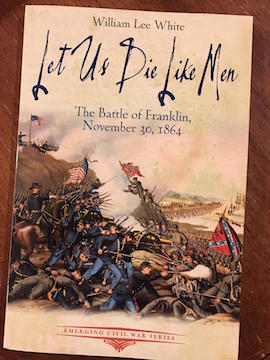Let Us Die Like Men Now Available
 In the fall of 2013, after finishing up Bushwhacking on a Grand Scale: The Battle of Chickamauga, Lee White asked about working on a second book. He had a lifelong fascination with the battle of Franklin, he told me. While it was a famous battle best known as the Confederacy’s most Pyrrhic victory, he said it was often misunderstood and underappreciated.
In the fall of 2013, after finishing up Bushwhacking on a Grand Scale: The Battle of Chickamauga, Lee White asked about working on a second book. He had a lifelong fascination with the battle of Franklin, he told me. While it was a famous battle best known as the Confederacy’s most Pyrrhic victory, he said it was often misunderstood and underappreciated.
We established Emerging Civil War, in part, to allow our historians to work on their passion projects, so we gave Lee the green light.
We’re excited to announce his much-anticipated volume is now available. It is the 29th volume in the Emerging Civil War Series (published by our good friends at Savas Beatie).
Let Us Die Like Men: The Battle of Franklin examines one of the Confederacy’s worst battlefield tragedies. After pursuing John Schofield’s isolated Federal force through middle Tennessee, John Bell Hood’s Confederates caught up to them at Franklin, where Schofield had chosen strong ground and hunkered down for a fight he could no longer avoid. The result was a Confederate victory but at such a cost that many historians have since called it the battle where Hood destroyed his army.
Lee’s book picks up after the fall of Atlanta and traces Hood’s highly effective North Alabama campaign that harassed Federal supply lines so effectively William T. Sherman finally decided to abandon his position—and his supply line—altogether and strike out to the Sea. (In that regard, Hood’s campaign may have been too successful!)
Rather than pursue Sherman, Hood decided to strike into middle Tennessee in a bold gambit to dislodge the Federal supply center in Nashville. Doing so would cut off Sherman completely and recapture vital territory for the Confederate cause.
This entire aspect of Hood’s campaign is traditionally overlooked, but Lee includes it as vital context for the late-November events at Franklin.
Once the armies converge at Franklin, Lee takes readers through wave after wave of Confederate attacks—each spelled out in one of Hal Jespersen’s great maps (the book contains eleven of them in all). The casualties mount. The attacks continue. Federal defenses waiver. The Confederates both win and lose. To this day, much of the Army of Tennessee lies buried on the field.
Let Us Die Like Men takes its name from a comment made by Confederate Maj. Gen. Patrick Cleburne, who saw the grim task before the army in the late afternoon of November, 30, 1864. If it was a suicide mission, he said, then he and his fellow officers and soldiers should die like men, doing their duty. They would be prophetic words.
The book has been a long time coming—we first announced it in March 2016!—but I’m not surprised. As a labor of love, I know Lee worked hard to get it right. I’m confident readers will not be disappointed.
Chris, having met Lee several times, including at one of your seminars, I know this will be a great addition to my library.
I wonder though about your comment that Hood’s “effective North Alabama campaign” was the reason Sherman decided to march to the sea. It was effective only in that Sherman got tired of the wild goose chase after Hood and decided to return to Atlanta to implement what he really wanted to do, the March to the Sea.
It may have been effective, in retrospect, if Sherman had implemented his original plan of only leaving the 4th corps behind to deter Hood from Nashville and taking the 23rd corps with him to the sea. Schofield convinced him that Thomas needed more than that to stop Hood, and so Schofield was given command of the 23rd and 4th during the Franklin-Nashville campaign. It was those corps, under command of Jacob Cox on the defensive line at Franklin, who met Hood’s fateful charge(s) — or as you put it, suicide missions.